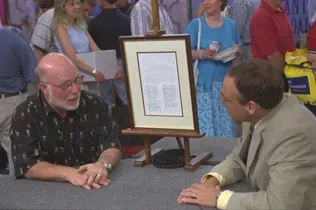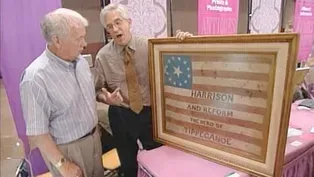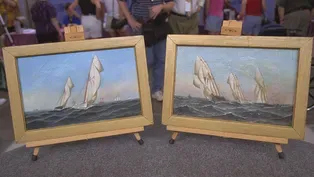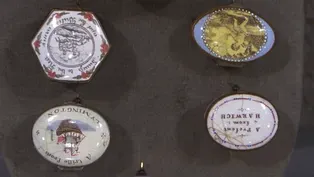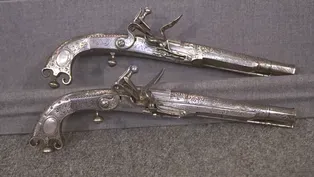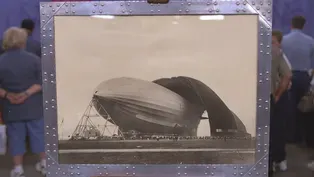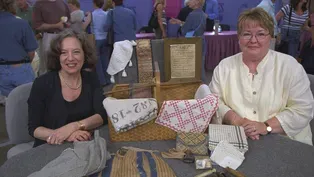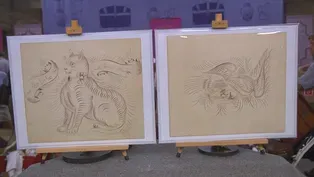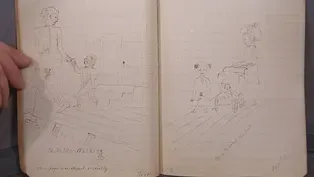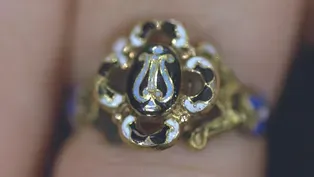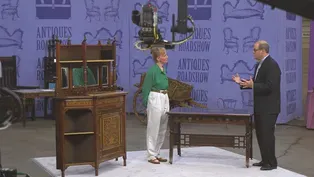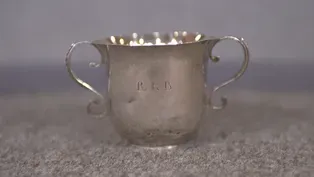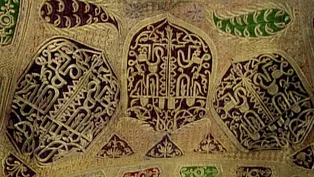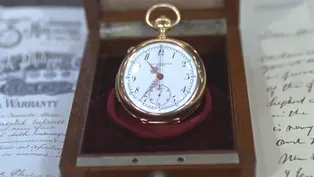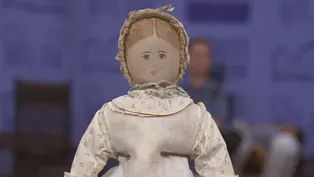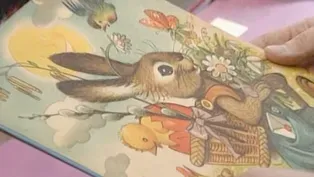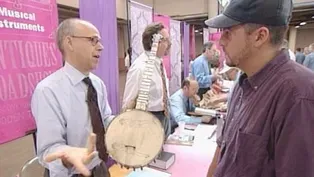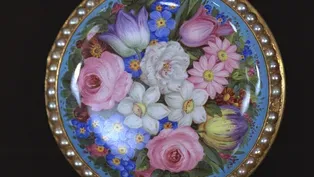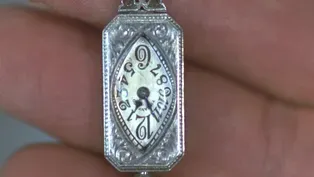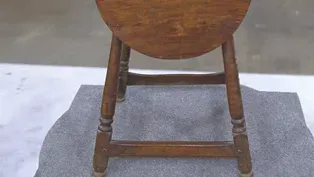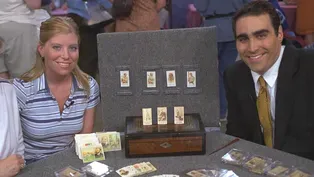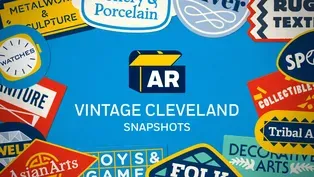

Vintage Cleveland
Season 21 Episode 22 | 52m 24sVideo has Closed Captions
Learn how the antiques market has evolved in the last 15 years.
Learn how the antiques and collectibles market has evolved in the last 15 years with updated appraisals like a 1979 Kent State apology, a Patek Philippe pocket watch, and a Herter Brothers sideboard and table. Which appraisal has increased $50,000?
Problems with Closed Captions? Closed Captioning Feedback
Problems with Closed Captions? Closed Captioning Feedback
Funding for ANTIQUES ROADSHOW is provided by Ancestry and American Cruise Lines. Additional funding is provided by public television viewers.

Vintage Cleveland
Season 21 Episode 22 | 52m 24sVideo has Closed Captions
Learn how the antiques and collectibles market has evolved in the last 15 years with updated appraisals like a 1979 Kent State apology, a Patek Philippe pocket watch, and a Herter Brothers sideboard and table. Which appraisal has increased $50,000?
Problems with Closed Captions? Closed Captioning Feedback
How to Watch Antiques Roadshow
Antiques Roadshow is available to stream on pbs.org and the free PBS App, available on iPhone, Apple TV, Android TV, Android smartphones, Amazon Fire TV, Amazon Fire Tablet, Roku, Samsung Smart TV, and Vizio.

ANTIQUES ROADSHOW 2025 Tour!
Enter now for a chance to win free tickets to ANTIQUES ROADSHOW's 2025 Tour! Plus, see which cities we're headed to!Providing Support for PBS.org
Learn Moreabout PBS online sponsorshipYou remember what you paid for it?
I paid a dollar for it.
What we have here is the genesis of baseball card collecting.
That's wonderful.
I cannot believe that.
Really?
Yep.
So it was a good investment.
WALBERG: When Roadshow visited Cleveland back in 2002, prices for Herter Brothers pieces were looking up.
But 15 years later, Victorian furniture is no longer the trend.
Those in the know claim if it's brown, it's down.
But is that true in this case?
Find out in this fresh look at Cleveland.
I have a dear friend who saw a show a couple of years ago, and there was a bowl of this shape and size with a nature theme to it, and she called me and said, "I think your bowl might be by the same person."
I had never, ever turned it over to look at the bottom of it, and it's very heavy.
So we hung up the phone, and I turned it over, and indeed, it was a Frackelton bowl.
It was in my grandparents' home.
They were married in 1902.
Went to my father, and then to me.
Susan Frackelton was in Milwaukee, Wisconsin, a very important figure in Arts and Crafts.
Before then, men were primarily the ones involved in the arts, and Arts and Crafts really got women into the decorative arts and designing pieces such as this one.
This is one of the few pieces of Arts and Crafts stoneware pottery that you'll ever encounter.
It's a wedding bowl, and it says here, "Love is the sweet wine of life."
And in the middle it has the initials of the people who were married, and the date, 1902.
The decoration on the inside is reinforced with clusters of grapes on the outside, so it's a punchbowl or a wine bowl.
Very beautiful piece.
Also it's very well marked.
If you look underneath it, we'll see that Susan Frackelton has incised "S" and then her full last name, Frackelton, underneath it.
And she's also put the date, 1902, on the bottom as well.
So you've not had this piece appraised.
You have no idea of value.
Never, never.
It's really hard, because you'll see a piece of Frackelton once every three or four years if you look for it all the time.
Consequently it's a little difficult to evaluate.
Easily, easily a $20,000 to $30,000 piece of pottery on a bad day.
And possibly, if the right museum got involved, $25,000, $35,000.
No.
Yeah, really.
Oh, my.
Thank you so much.
My pleasure, thank you.
Thank you.
It was great to see it.
Could you say that one more time?
$20,000 to $30,000, minimum, minimum.
And the right museum, $25,000 to $35,000, maybe a little more.
(sighs) Wow.
Me without my handkerchief.
You brought a document relating to the tragedy of May 1970, the shooting of students by National Guardsmen at Kent State.
How have you come to have it?
My father was a judge involved in the case, initially, in ordering the suppression of the grand jury report that came out of the state courts, and then after the students won the right to sue for their injuries, and they had to go to the United States Supreme Court for that, the case then came back to him, and he was the trial judge when they finally brought the case to a conclusion.
And the settlement was for $675,000, and something else.
$675,000 to the plaintiffs.
And the plaintiffs wanted to have an apology, because they weren't getting as much money as they thought they should get, I believe is the reason.
And the governor and the state were not willing to give them an apology.
And so my dad brokered the deal by sitting at his manual Royal typewriter and typing out an agreement that both sides could live with, and this is the document.
That's what this is.
You're right-- the money, in retrospect, especially, seems like very little.
The families of the slain students received just $15,000 apiece.
The one student who was paralyzed received $350,000.
But in addition, they got this apology, which states that in retrospect, the tragedy of May 4 should not have occurred.
It admits that "some of the Guardsmen "on Blanket Hill, "fearful and anxious from prior events, "may have believed in their own minds "that their lives were in danger.
"Hindsight suggests that another method "would have resolved the confrontation.
"Better ways must be found to deal with such confrontations.
"We deeply regret those events, "and are profoundly saddened "by the deaths of the four students "and wounding of nine others which resulted.
"We hope that the agreement to end this litigation "will help to assuage the tragic memories regarding that sad day."
And it is signed by the defendants, Governor Rhodes, who signed here, Sylvester Del Corso, who was the adjutant general of the Ohio State National Guard at the time.
And the other signatures are all of the National Guardsmen who were on duty on campus that day who were involved in the shooting.
It's difficult with something like this to think of it in monetary terms.
And we very seldom see something from such recent history that strikes such a chord.
I think I would try to take into mind the passion that this would excite among many people who lived through this.
I would certainly think an insurance value of $10,000 to $15,000 would not be too much.
Thank you very much.
You're welcome.
MAN: Well, it belonged to my great-grandfather and it came down through the family.
APPRAISER: Now, this is a watch made for the Chinese market.
And there was an entire industry in Switzerland, centered in the town of Fleurier, which produced in the early part of the 19th century watches that were sold exclusively to a Chinese market.
Typically, they have this wonderful floral enamel on the back.
But yours is more special than that.
Now, we can turn this over and look at... the other side of the watch.
When we first saw the floral enamel, we saw the pearls around the outside of it.
This once had pearls around it, too.
And I understand this has had sort of a sad history.
That's correct.
It was confiscated by the Communists during the Cultural Revolution, and when it was returned, the pearls were gone.
How did you get it back after the Cultural Revolution?
It was returned to my family, and it came down through my mother.
The front of the watch really is pure Swiss, and it depicts a scene out of Greek mythology known as "Cupid's forge."
And what makes it even more interesting is that it's an automated scene.
Watches like this are very highly prized by collectors, and even though many watches are not terribly valuable, these have always been very sought-after.
We think that if you had to insure it, you should think in terms of $35,000, perhaps to $40,000.
It's quite a nice watch, and you should be very happy that it survived, and I'm delighted to hear the story of the watch.
Thank you.
WOMAN: It's been told in the family that it came over on the Mayflower.
Unfortunately, this couldn't have come from the Mayflower, or even from the 18th century.
It's made by a four-color printing process that was developed in the middle of the 19th century.
So this was probably made in the 1870s or 1880s.
APPRAISER: This label can be a little bit misleading, because as you can see, it shows the piece originally was sold in Chile.
However, this piece is not Chilean at all.
It's actually French.
And we know that because of this cameo signature here, Charter.
A great Art Deco piece, and I think that on today's market, this piece would very easily fetch about $1,000.
Thank you very much for bringing it in-- it's lovely.
They are from the Song Dynasty.
The Song Dynasty was 960 to 1250 A.D.
These were tea bowls, and they were very highly prized by the Chinese as well as the Japanese.
Probably for the two, $800 to $1,200 at auction.
I play five-string banjo, and when I was about 18, I had a friend of mine draw a bird on it.
Birds again.
Nothing like this.
I mean, I think this would be banned in Boston, quite frankly.
But wonderful, racy, racy illustrations here.
They're really terrific.
Equally, I think, as important is the instrument.
It is unsigned, unlabeled, but we know what it is soon as we pull it out of the case.
It was made by S.S. Stewart in Philadelphia, Philadelphia being one of the more important schools of banjo making.
Classic Philadelphia school is this sort of pediment head on it with a combination of pearl and silver wire inlay.
Wonderful fingerboard here with pearl and abalone inlay.
I date it...
Looking here at sort of the quality of this carving, I'm thinking more 1900, 1910.
Though these gals here look a little bit more like 1930, or the 1920s.
Today, this banjo, $800 to $1,200.
Cool, cool.
Yeah, very nice.
Nice quality.
Great for frailing, traditional-style banjo playing.
I inherited this piece from my great-great-aunt Sue, who was Lady Suzanna Tweed, who was married to Carlton Tweed, who invented the valve on the tires on your car.
No kidding.
Yeah, my uncle invented many things.
He was deaf, and he was an incredible man.
Well, it was a beautiful piece of jewelry that he bought for your aunt.
Now, this is a diamond pendant on the face.
But if we turn it around, we see that it's also a watch.
Now, the watch has a movement made by C.H.
Meylan.
However, it was retailed by Tiffany and Company.
It's all single-cut diamonds around the outside border.
And then the two largest stones, the one in the center and the one on top of the bale, are marquis-cut diamonds.
In total weight, you have around two carats.
Oh, wow.
And if you look on the end, you'll see there's rose-cut diamonds in the crown.
It's all beautifully executed, nice mill graining along the edge of the diamonds, and it just all comes together.
It's a very sweet piece.
In the current auction market, I would say this may fetch $3,000 to $4,000.
Wow, great.
Fantastic.
Have you worn it?
Yes, I have.
Oh, you have?
Yes.
So you've been enjoying it?
Oh, yes.
Well, that's great.
It's an attention-getter.
Oh, yeah, I'm sure.
It's fabulous-looking, come on.
Well, this is a collection of photographs and correspondence regarding family members from the turn of the century and the latter part of the 19th century, primarily revolving around James Wormley and the Wormley Hotel in Washington, D.C. And James Wormley was your great-great-grandfather.
He would have been my great-great-grandfather, that's correct.
He was an African-American who owned what has been characterized as the preeminent hotel in Washington.
It was right at Lafayette Square.
And we have a picture of the hotel up here.
It's no longer standing, unfortunately, but that's a marvelous old shot of it.
Now, James Wormley also had another interesting distinction.
In 1865, he was a participant in a fairly historic event.
Can you tell us a little about that?
Yes, he was actually at the deathbed of Abraham Lincoln.
He was always called whenever there was a time of emergency or urgency, and he actually was portrayed in the Littlefield picture of Lincoln's deathbed as the only African-American in that image.
Well, one of the things I think is so interesting about this is the range of your family archive.
And you have photographs, wonderful tintypes.
Here's a little broadside on the death of James Wormley.
You have them in good albums here, where they're protected from handling and wear.
You've got them labeled wherever you can, because memories fade, and if you know who someone is in a picture, get a label on it, as you've done.
This is very unusual to see an African-American family archive of this extent.
And I think just for its unusual qualities and his historic figure, I would value this at about $5,000 at least, maybe more.
Thank you very much, I appreciate that.
Thanks for bringing it in.
MAN: I got it at a flea market.
I saw this, and it seemed like a really great object.
The frame seemed like the original, and... What'd you pay for it?
A few hundred dollars.
And how much is a few?
About three, I think.
This is a great photograph, and it's one of the sort of iconic photographs of American aviation.
Do you know what the photograph is of?
Yeah, there's a little plaque on it.
It's the Goodyear zeppelin.
And did you know this is the maiden flight of the Goodyear zeppelin?
No, I did not know that.
This is the USS Akron, which was one of two zeppelins made by the Goodyear Corporation, the other one being the Macon.
And this is the air dock that the zeppelin was in.
It's in this great frame, which is made of the same kind of material that they used to frame the rigid structure of the zeppelin.
If you look over here in the corner, there's a signature there.
Can you read that signature at all?
I can't.
Well, it's signed by a great 20th-century photographer whose name was Margaret Bourke-White.
She worked for LIFE magazine.
Really?
This was one of her signature photographs, and really one of her most famous photographs.
Great.
This particular photograph in this frame outfit-- and you can see the label here, it mentions something about the Goodyear zeppelin race-- these were given out to top salesmen for the Goodyear Corporation for selling tires and that sort of thing.
There's a great auction record for these kinds of photographs.
The good news is that they're very collectible.
The bad news is, the value of them has started to decrease.
About 15 years ago, when the first one came on the market, it sold for about $15,000.
Really?
Since then, the market value has started to go down and down and down.
But even so, with it being signed by Bourke-White, being in great shape, its value is somewhere between $5,000 and $7,000.
Really?
Yep, no question about it.
So it was a good investment.
I think that for 300 bucks, you did okay.
Yeah, great-- that's great news.
I collected them because I have such respect for them.
They were always such humble items.
But some woman worked hours, maybe days, on every single item, because they're all, for the most part, handwoven and even handspun.
When did you start collecting?
Oh, I've collected for probably 30 years.
Is there a first item here that you collected, or a special item?
Yeah, I guess the pockets-- I love the pockets.
Why don't we hold them up?
Yeah.
What's the little rhyme that you know?
Oh, "Lucy Locket lost her pocket."
Do you know how she lost her pocket?
No.
Because they were tied around her waist.
And so these pockets, you know, if your string came undone, your pockets fell off.
And all kinds of things were carried in a pocket.
I mean, it was a lady's handbag of the 18th and 19th century.
And a dress had slit on the side, and you had to put your pocket, your hands into your dress, and you could pull things out.
And we know from newspaper records that when women lost things, they would say, "Lost in my pocket."
And you would find things like, oh, a pocket watch, and your clips, and your jewelry, and your notecards.
Okay, okay.
And all kinds of things.
And they're made of very humble cloth, so it's probably not a very wealthy woman.
Right, right.
What else do you love that's here?
I love the apron.
The apron is a real treasure.
You can see here that it opens up down the back.
And do you know how to date this apron?
No, I don't, really.
I think it's pretty early, but I don't know how to date it.
It is early.
It's got this very thin seam right here, indicating that there's a very short bodice in the back.
And I would date this to about 1805.
I never noticed that, okay.
What'd you pay for this?
I paid $700 for that apron.
My husband bought it for me.
Well, I think he did a good thing.
I can't tell you how rare this is.
Sometimes the simplest things are the rarest things, and they don't survive.
I would value the apron at about $1,500.
Oh, well, that's a good thing.
And the pockets at about $1,000.
That's wonderful.
And I would value...
This purse here?
Yes.
Which is dated 1812, at about $1,500.
Oh, that's wonderful.
So if I begin to think about the value of your collection, it's worth quite a lot of money, you know?
$6,000 to $8,000.
Oh, my goodness-- well, thank you very much.
APPRAISER: Dominick Labino invented the process where glass could be melted at much lower temperatures, and now they were able to make furnaces and put them in studios, and it started the studio movement.
And this is the man from your state of Ohio that did that.
Wow, I didn't know that.
MAN: I got it for five dollars.
APPRAISER: You brought in this wonderful dance card.
On the inside is a program that lists all the different dances that were going to be held, and then the women would get their partners and pencil them in.
You bought it for $5, and now at auction, it would probably be between $2,000 and $3,000.
Oh, my goodness.
Wow, that is a surprise.
APPRAISER: There's two tiles here, and they're majolica glazed.
It's a very beautiful, rich blue color.
I think the piece would be a fair market value of around $1,200 to $1,500.
Very good.
MAN: About three years ago, I went to an estate sale, and I found those in the attic, and I purchased them for a dollar apiece.
Dollar apiece.
When you came in, I thought these were some kind of big postcards or something.
I didn't even realize they in fact were books.
But not only are they books-- we've got Ricky the Rabbit-- we open them up, and what we get is an incredible pop-up book, dramatic pop-up book.
And it was printed in Czechoslovakia, sold and distributed in England.
So I don't know how it got to where you were able to get it, but it got there.
And here's the other great one, Tony and the Circus Boy.
Another dramatic pop-up book.
These are great, they're very collected today.
In this condition-- they're in very pristine condition, all the parts are present, no damage-- they would be very sought-after for children's book collectors.
And you surely got a good deal with this one, because I would value each one of them at $650.
So together you're looking at about $1,300.
So that was good going.
That is wonderful, that's great.
It's a piece that's been in my family since it's been made.
It was made by an ancestor of mine through my father's side of the family.
And where were they from?
Southern New Jersey.
That's Monmouth County, that area?
Most likely, yes.
Now, have you ever had it appraised?
When my grandparents took possession of it, there was some interest from an antique dealer.
And she started some correspondence with them.
And the correspondence we had was from 1941, which certainly is World War II.
And her concerns and her sales pitch, or buying pitch, if you will, was the state of the world today, being 1941, that the table should be in a fireproof building, perhaps a museum.
Okay, and did she quote a price?
$300 in 1941.
This table dates mid-1700s.
It is spectacular in that it's all original.
It's tiger maple, which is quite desirable, and it has its original surface.
Now, this table is a tip-top table.
There were chair tables also.
These were very useful pieces of furniture that could serve many different functions.
Now, this table, when you turned it around and placed it next to your chair, you would put a candle here so you could read.
And do you know why the top was tilted when you were doing that?
Well, I assumed that it was to block some breeze, to keep the candle lit.
Exactly, the early American homes were very breezy.
And you can tell that this was used as a candle table.
This is where the candlestick would have been held, and maybe the breeze got a little bit more than they had hoped, and there's this wonderful burn mark here.
Now, that is something that tells great history.
You should never, ever have that taken out, and you should never refinish the table.
I won't.
Now, the most unusual thing about this table is, it can also be made into a flat top table, which has a unique mechanism which we've never seen on a table of this period.
And one of the very nice features is the drawer, and these wonderful tiger maple legs that splay with the box stretchers.
These original battens, as we call them, have never been disturbed, and the finish has not.
And on a piece like this today, it is worth $20,000 to $30,000.
Well, thank you.
You're welcome.
When my grandmother died, my father was cleaning out his bedroom, and in his closet, in his bedroom, he found the box with some other assorted things.
When he opened up the box, he saw all of these cards in there with other odds and ends inside the writing box.
So that's where the box comes from.
And when we looked in the box, we realized that the cards were very old, and they were in excellent condition, so of course, we're concerned about how much they're worth, and how to preserve them.
What we have here is the genesis of baseball card collecting, okay?
This is the late 1880s, and these were tobacco cards.
These were actually put in packs of tobacco as stiffeners.
Yeah.
Now, people collected them.
Some people gave them to kids, some people pasted them in scrapbooks.
These were put in this beautiful box and tucked away for 100 years.
You don't really see that too often, okay?
This first set here, these are called Allen and Ginter cards.
And you can see the most beautiful color lithography you've ever seen, just fantastic.
And here we have four of the best cards in this group.
These are four Hall of Famers-- we have Tim Keefe, we have John Montgomery Ward, we have Charles Comiskey, who Comiskey Park is named after.
We recognized that name.
And Adrian "Cap" Anson.
These are the best cards in this particular set.
Now, you also have these right here.
These are called Old Judge cards.
These are also from the 1880s, and it's the first card to actually use a photographic image.
And here we have three of your best ones in this collection, including Hugh Duffy, who's a Hall of Famer, Jim Mutrie, the manager of the New York Giants, and Buck Ewing.
Here we have the most beautiful cards I've seen in years.
I mean, these are just absolutely pack-fresh, if you will.
So you have about 40 of these.
Collectors look for condition.
That's the number-one thing.
They're also looking for the individual, obviously.
As far as value is concerned now, I would estimate the collection that I see right here at approximately $12,000 to $15,000, okay?
Oh, my gosh, yeah.
It's a wonderful collection, it's very exciting to see, and thank you so much for coming in.
Thank you.
Thank you.
WOMAN: This is a pocket watch that belonged to my late husband's great-grandfather, and he was an inventor who lived in Cleveland.
And his inventions mainly had to do with the steelmaking industry.
And he had a number of patents and a number of other inventions.
The thing about it that I'm so impressed with first off is superb quality.
And even more importantly, the fact that you walked in here with a watch not only in its original box, but all this documentation-- the original bill of sale, the warranty, and even a letter regarding the piece, which only enriches my interest in the piece and puts it in context, if you will, because we know a little bit more about the man for whom it was intended.
I think first of all, if I may, I'll quote just what it says on the bill of sale.
"This stemwound lever escapement watch "with compensated balance, 35 jewels, "minute repeater chronograph, split-second open-faced gold polished back."
This had everything that money could buy.
The watch was one of the finest timekeepers of its day.
Patek Philippe sold watches of a superior quality to a very discerning clientele.
It's accompanied by its warranty.
On the bill of sale, we will notice at the bottom, the watch cost, when it was new, about $450, which is about the price of an automobile back then.
It's a great deal of money.
Now, if we may, we'll look at the watch briefly.
And Samuel T. Wellman's monograph is on the back of the watch, engraved.
Then we look at the movement, which is very complex and very interesting.
And if I may, I'm going to quote from the letter that accompanies the watch.
"Although the contrast is very great "between such a delicate little machine "and the ponderous and powerful machines "which Mr. Wellman has devised and put into operation, "I know of no one who will appreciate more than he "its beautiful and intricate systems "of levers, gears, wheels, all of which work together in such perfect harmony."
I mean, that's great stuff.
Well, this watch was, in its time, really just about the best that money could buy.
I think in today's marketplace, this watch is worth probably in the area, for auction purposes, between $15,000 and $20,000.
It's a treat to see it.
It's really quite spectacular.
Well, thank you very much.
What's the date?
1544.
Yeah, that's pretty old, wouldn't you say?
It's one of the very first treatises on law ever published in English.
My guess is about $1,500 to $2,000.
Wow, thank you.
We see a lot of these on Antiques Roadshow, not just dogs, but figures of all types.
They're made in Southeast Asia.
And did you buy it in the last couple of years?
Yes.
Okay.
Yeah, they've been importing these for about five or six years now.
They look very convincing, they're very ornamental, but they are modern Southeast Asian-- porcelain copies of Staffordshire.
And they're priced too good to be true.
And you see them all over antique malls.
WOMAN: It was a friend of mine that owned it.
It belonged to her great-grandmother.
And the story goes that she supposedly made molasses in this.
It's probably going to sell for $300 to $500.
(laughing softly): You're kidding.
Yeah, and I don't think that it ever had molasses in it.
I doubt it.
(laughing) What we're looking at here, the face of the object, is an Ottoman Turkish horse blanket.
And it's metal thread that's been embroidered on velvet.
And it's a type of object that would have been incredibly popular and collected at the end of the 19th century and the early 20th century.
This piece is probably worth about $1,000.
And the reason it's worth $1,000 is that if we look at the back, it's been lined with a Central Asian silk peacock, which is another type of fabric that, in the end of the 19th century, was only considered worthy of being used as a backing material.
But today, all of the interest for collectors is actually in the backing material and not the surface.
Unbelievable.
It's a great explanation as to how value changes and how the market changes, out of interest.
That is amazing.
WOMAN: My mother had a friend, Miss Foster.
And Miss Foster was 90 and going into a nursing home, and Mother said, "She would like you to come over and pick out something from the apartment."
And I saw this young boy, and I said, "He's darling-- may I have him?"
And Miss Foster said, "I'd love you to have him."
This is a sculpture by an artist named Augusta Savage.
And she was a black artist who worked in New York in the 1920s and '30s.
And this is her most famous work.
It's called Gamin, and it's inscribed on the front, "Gamin."
Uh-huh.
And the piece is signed on the back with her name, Savage.
And while it looks like it's bronze, it's actually made out of plaster, and it's painted to look like bronze.
And if you look on the bottom here, you can see the white plaster.
She didn't have the money to cast them in bronze.
It was a very expensive process.
This is a wonderful piece.
It really captures the spirit of this young boy.
It does.
It comes in this size, and there's another version that's slightly larger.
Oh, did she make many of them?
No, not really, because there just wasn't a demand for them, and I think even if she made a lot of them, because they're plaster, they're very fragile.
In fact, yours knocked over and cracked.
Yes.
Well, I think you might be surprised.
This is worth between $15,000 and $20,000.
With the crack?
With the crack, yes.
Isn't that great?
That's wonderful, I cannot believe that.
I...
It can even bring more.
Well, I picked it up at a flea market and it was really tarnished.
When I cleaned it off, I noticed some marks on the bottom, but I couldn't identify them, so I wanted to find out where it came from and how old it was.
You picked it up at a flea market?
Yes, I did.
You remember what you paid for it?
I paid a dollar for it.
Well, this is a piece of American silver made in Boston, Massachusetts, about 1710.
Oh, my gosh.
I'd like to show you the marks on this cup, which are here on the bottom.
And they tell me that this was made by John Dixwell in Boston.
The American silver makers stopped using hallmarks of this nature in the 19th century.
So it's a beautiful 18th-century American silver cup.
Very rare.
300 years old.
Wow.
In a well-advertised auction, a little two-handled cup like this with this kind of vintage would be estimated in the range of $2,000 to $3,000.
Oh, my gosh.
Oh, my gosh.
Thank you very much for bringing it to the Roadshow.
Oh, thank you.
MAN: I bought them in 1977 when I was stationed in the Navy in Thurso, Scotland.
I see.
And I bought them from a jeweler there.
I gave him 500 pounds for them, which was quite a bit of money, which was close to $700.
Mm-hmm.
I wanted to take something nice back from Scotland, and I brought these back.
Well, you brought back a very nice pair of all-metal Scottish pistols.
They're signed by John Campbell, who worked in Perthshire, Scotland.
There were three generations of Campbell gunsmiths, and they worked from around 1710 to 1790.
And they were excellent craftsmen.
These are absolutely wonderful, all-metal pistols, and it's unusual to have a pair in such nice condition.
And if you'll notice, they have the ram's horn butt here.
And...
They have the belt hook here, and they have wonderful baroque chasing.
They're just... these are just magnificent.
And the fluting here, and this is a typical trigger on a Scottish all-metal pistol.
These are as fine a pair of pistols as I've seen, and you should be very proud to have them.
I did take them to a gunsmith in 1985, and he told me they were worth about $1,500 to $2,000.
I think that they're easily worth $12,000 to $15,000.
(laughs) Geez.
So, Sailor Boy, you did a good job.
Wow.
That was a good investment.
I think they're going in a bank now.
You don't want them to go in a bank-- you want to look at them.
But insure them.
I didn't realize that they were that valuable.
But I know they're very pretty.
Well, we know that it was my grandmother's great-aunt's doll.
She was born in the mid-1800s, and we know the doll came from Lancaster, Pennsylvania, and it was made by the Moravians.
That's all the information we know.
Right, well, it's a lovely rag doll.
It's got a beautifully hand-painted face, all-cloth body, super clothes, great leather shoes with a keystone from Pennsylvania on the bottom.
And the family history's pretty good.
It is a Moravian rag doll.
And it was made in Pennsylvania.
A lot of them were made in Bethlehem, Pennsylvania.
And there was a lady by the name of Polly Heckewelder who had the sewing society for the Moravians.
And Pennsylvania's very well-known for the Amish, Mennonites, and the Moravian society is a little less well-known.
These dolls actually were made for children to play with.
They weren't just a decorative object to sit around a Victorian parlor.
But this particular one, somebody really never played with it very much.
In today's collecting society in America, rag dolls are very, very, very, very popular.
And they call this the Polly Heckewelder rag doll.
And this might be actually one of the original ones made in 1872, which sort of goes with your family history.
I sold a Polly Heckewelder rag doll, made in 1900, for $2,000.
So if this is one of the original ones from 1872, you're probably looking at $4,000, $5,000, or, if you get a rag doll collector, whatever... American rags are very competitive, very popular, and very hard to find, especially in this pristine condition.
I mean, Polly is a darn beautiful doll.
There was a very important school of painters at Liverpool, and one of the most important of that school was a man named Samuel Walters.
And he was at the height of his career in 1850.
Similar paintings to this have been selling in the last two or three years for $40,000 to $60,000.
Wow.
That's unbelievable.
We see a lot of Satsuma ware, basically earthenware made in Japan, turn-of-the-century, a lot of it for export.
A good mid-level piece, I'd say $1,400-$1,600, okay?
Nice piece.
Great.
This is a marvelous patriotic symbol, and a very unusual folk art one, being in the form of a carved flag.
We're probably looking at $4,000 to $6,000, probably, as an auction estimate.
Very nice, very nice indeed!
The decoration is what we call Fairyland Lustre.
And in fact, there are fairies and gnomes that surround the inside of the bowl.
The background color, because it's orange, we call it Flame Fairyland.
Now, Wedgwood produced this in bone china in the 1920s.
This has a number of wonderful characteristics for it.
First, it's not a typical bowl, but it's a footed bowl.
Next, you see the little elves on the outside, and they're leapfrogging.
And this particular pattern is actually called Leapfrogging Elves.
And it's got this wonderful verse around the outside.
And I was looking to see where it began, and actually, I think I found it.
It says, "Gray for the goblins, blue for the elves, "Brown for the little gnomes that live by themselves, "White for the pixies that dance upon the green, But where shall I find me a robe for the queen?"
Yes.
That's wonderful.
Signed on the bottom with the Wedgwood, and this is the bone china mark that one would have expected for it to be manufactured about 1920.
Now, these were designed initially by a lady called Daisy Makeig-Jones.
And she just had wonderful imagination.
But seldom do we get signed pieces of Daisy.
This piece is signed in the rocks-- MJ.
We almost never find them.
That, and the fact that it's in perfect condition, on the market today, I would expect it to bring anywhere from $7,500 to $10,000.
Oh, that's wonderful, wonderful.
WOMAN: I always thought it might be a poison ring, because it opens up.
APPRAISER: Show us how it opens.
It's got a hinge, and it closes tight, and that's it.
Okay, could you take it off, and we'll put it down here?
I think everybody has this conception that if a ring opens up and it's got a compartment, it's a poison ring.
They heard these stories about Lucrezia Borgia, they read the books.
This ring is made about 1830.
It's enameled on gold.
It's probably Swiss or perhaps French.
And what they wanted was a little snip of their loved one's hair-- a husband, a wife, a child.
If they went on a journey, that was what they could keep close to them.
And they would open it up, and this was a receiving compartment.
They would put the little lock of hair inside, close it up tight, and it was always close to them.
It was sentimental.
Now, even though it's not a real poison ring, but a compartment ring, an enameled compartment ring like this today has a value of about $2,500 to $3,000 in the collector's market.
Wow.
Well, this is a sort of a diary that my grandfather had written.
He was a teacher, missionary, educator in Unalakleet, Alaska, back around the turn... Unalakleet?
Unalakleet.
My grandmother had sort of chased him down to Alaska, decided that she wanted to marry him, and she tracked him down.
She went pretty far, right?
She went to the end of the earth.
He couldn't go any further, so she kind of had him.
This is a diary that he wrote when my grandmother and mother and two brothers had left him for a while.
So he's recounting his time alone.
He writes some text, and then he even drew some pictures to amuse them.
Here's a picture of Daddy with my Uncle Bill, my mom, Ruth, and Elmer, the youngest one.
Incredible.
And he's named who they are, and you can see your mom there, your uncles.
And what brought him to Alaska?
Was he...
He was a minister, and I think he just thought it was something that he should do.
I'm certain it was a government program, because some of the documents suggest that he was on the government payroll for a while.
So he was working, teaching.
This other item is a magazine that he edited, correct, when he was up there?
Yes.
I think he created it and everything.
He created it, edited it, probably illustrated it.
Called Northern Lights.
And the very interesting thing here is the fact that, to establish any kind :of printing in Alaska, this remote area that you talked about, is... would not be an easy undertaking.
And to get the equipment to do it was quite a commitment.
And he brought it to the Eskimo children, and he had them actually publish the magazine.
So he actually taught them to publish and produce this magazine, this newspaper, for themselves, and to educate them.
It says, "It is our plan, "by the help of the pupils, to publish the paper "monthly at Unalakleet, in the interest of the schools of Alaska."
There's about two years worth of them bound in here.
It's only a few pages each, but it gives interesting talk of what's going on, recipes, local news, school news.
But it is a really... a very professionally done and organized newspaper.
And again, something like this is very ephemeral and would disappear and not likely be seen if you hadn't brought it here to the Roadshow.
It even says in there that this is the only Eskimo newspaper in existence.
I saw that.
And that may very well be true.
And that with the diary, and you also had some other papers related to his travels.
He had kept detailed expenses, so you can find out what reindeer meat cost on June 13, 1913.
The cost of reindeer meat.
Altogether, for insurance value, I would easily put this at $5,000 to $10,000.
Oh, my goodness.
The combination, I mean, it's such a fabulous story, very interesting man, and you're very lucky to have that history in your family.
It's wonderful to have in our heritage.
Thank you for bringing it in.
Well, thank you very much.
Thank you.
My father-in-law and mother-in-law were collectors of many different things over the years, and this was just one of their collections.
And did they visit England to collect these boxes?
They did.
These little boxes were made in England in the 18th century.
They were made either in South Staffordshire, a little area called Bilston, or in London, in Battersea.
And they were given as little tokens and trinkets from one loved one to another.
And even today, that's how they're collected and given, as presents to collectors.
Now, I'm going to just point out this one in particular, which I like, which is entitled "A Trifle from Limington."
Do you know what these were used for?
No.
Well, they're called patch boxes, and they were actually for ladies to keep their beauty spots in.
So a lady would keep her beauty spots in here, she would take one out on her little finger, and she'd place it in the prerequisite position, checking with the mirror inside the box it's in the right place, and then replace it.
So they're little patch boxes, and they became mementos from places one would travel to.
You've got ones from Harwich, Leominster in Herefordshire, and in Limington.
This one is also a particularly interesting one, and slightly controversial.
It says, "Success to the fleet and the British army."
And I think that meant the British army possibly fighting against America at the time, so I do apologize for that one.
The other two at the bottom here, both these are French enameled boxes, again of the 18th century.
And I think they're absolutely charming.
Now, remember, condition is very important when you look at these.
There are some cracks and chips.
If these boxes are in perfect condition, they can make a lot of money.
Once they're damaged, the value halves.
And I've totaled up the damaged ones with the perfect ones, and I would say that you should insure them for about $3,000.
Wow.
Indeed.
If you ever go to London, there's a little shop there that specializes in selling these.
You'll be shocked by how much just one would cost you.
So thanks for bringing them to the Antiques Roadshow, and thanks for making me feel homesick.
Well, thank you-- it's been a pleasure.
They come from the Charles Myers estate, and he was on Millionaires Row in downtown Cleveland.
My great aunt worked for him, and she was his chief cook and housekeeper.
And when he died, he left her these pieces, and they came down through her brother, who was my grandfather.
Well, as style changed, people relegated their furniture, even their high style furniture, upstairs to the servants' quarters, and it was largely dispersed.
Do you know a little bit about the furniture?
Yes, they Herter brothers actually were the furniture makers in the 1880s that also worked on the Vanderbilt Mansion down in North Carolina, and they were well known for their architectural interests.
Some of the titans of industry-- Vanderbilt, Pierpont Morgan, they all loved Herter Brothers.
The Herter brothers were the perfect combination to carve and develop this aesthetic style after the Civil War.
These fantastic inlays that you see here emphasize the naturalism that the aesthetic style really was all about-- these wonderful owls and birds, the wonderful carving on the columns.
This fantastic inlay on the panels, it was all about bringing that elaborate and naturalistic style into your living room.
If you open up the door, you'll see that this is actually not just a sideboard, but it's almost fitted as a desk.
And what's so exciting to me is that if you walk over to this piece, this is in fact a library table.
And so this was a suite of furniture.
And what's so remarkable about this set of furniture is that it survives together.
Yeah.
This finish on this piece has a wonderful old surface.
Oh, yeah.
And that actually is a premium.
This finish was very much like that, but my mother had set plants on it, and my niece watered them, and the water from the plants totally... so we've had this refinished, see?
This has never been touched.
Well, this is an example where refinishing certainly does affect the value, but not greatly.
Sometimes the rarity of a piece will supersede the condition issue.
Because of the rarity, it will only diminish it slightly.
20 years ago, a table like this would probably be bringing $8,000 to $12,000 in the marketplace.
My goodness.
Pretty good.
Yep.
The sideboard and the library table today probably are worth $100,000 to $150,000.
Oh, my gracious, sir.
Well, my Aunt Anne would certainly be very proud of that, I'm sure.
It's remarkable, isn't it?
Yes, it is.
My grandfather acquired them, and I'm sorry to say that I cannot tell you the history of that acquisition.
When he passed away, they came to my mother, who truly loved them, and she saw that I had them upon her death.
You know who they're by, right?
I do know who they're by, and I know that he is a top-notch maritime painter.
Antonio Jacobsen, right?
Jacobsen, thank you, yes.
That's right.
You know the subjects, don't you, or you know what they are?
The America Cup races, yes.
Absolutely.
Antonio Jacobsen is a Danish artist.
It's spelled Jacobsen, S-E-N. And he comes to America, living in New Jersey.
Sometimes he signs these with his address, so we can date them by the address.
But he actually dated this one 1885.
And he has this business painting basically portraits of boats.
That's almost all he does.
He's painting different people's ships in harbors in and around New York.
Did you ever figure out who these boats were at all?
No, no, I don't know.
We know it's an America's Cup race, because we have this little light ship.
This is the ship that they all went around.
And we know the year, 1885, so we know this is the Puritan and the Ginesta.
These, I'm not so sure.
We could probably figure that out.
That could be known by the pennants that they have.
Only one of these is signed, so it's important to keep these two together.
Yes.
If you have children, do not separate these.
Because this one will validate that one, okay?
This one without a signature will not ever be worth as much as the one that's signed.
I see.
But together, they make a pair.
We have two sons, and that's what I probably would have thought of doing.
I thank you.
They're going to have to fight for that, yeah.
The thing about Jacobsen, you rarely see racing scenes.
Most of these are just plain foursquare portraits of ships.
And here you have these very active racing scenes.
We have the men hiking out on the sides to counterbalance the boat.
You have this very dynamic sea.
All these make them probably the most valuable Jacobsens that I've ever seen.
Because they're known America's Cup scenes, I would estimate these to go at auction-- and this market is very hot right now-- somewhere between $50,000 and $70,000.
Oh, my goodness.
Yeah, absolutely.
(laughs) It's mindboggling.
I had no... no idea.
WALBERG: I'm Mark Walberg.
Thanks for watching.
See you next time on Antiques Roadshow.
Appraisal: 1840 Harrison Campaign Flag
Video has Closed Captions
Clip: S21 Ep22 | 1m 3s | Appraisal: 1840 Harrison Campaign Flag, from Vintage Cleveland. (1m 3s)
Appraisal: 1885 Antonio Jacobsen Paintings
Video has Closed Captions
Clip: S21 Ep22 | 2m 24s | Appraisal: 1885 Antonio Jacobsen paintings from Vintage Cleveland. (2m 24s)
Appraisal: 18th C. Patch Boxes
Video has Closed Captions
Clip: S21 Ep22 | 2m 31s | Appraisal: 18th C. Patch Boxes, from Vintage Cleveland. (2m 31s)
Appraisal: 18th C. Scottish Pistols
Video has Closed Captions
Clip: S21 Ep22 | 2m 9s | Appraisal: 18th C. Scottish Pistols, from Vintage Cleveland. (2m 9s)
Appraisal: 1931 Margaret Bourke-White Photo
Video has Closed Captions
Clip: S21 Ep22 | 2m 11s | Appraisal: 1931 Margaret Bourke-White photo from Vintage Cleveland. (2m 11s)
Appraisal: 1979 Kent State Shooting Apology
Video has Closed Captions
Clip: S21 Ep22 | 3m 10s | Appraisal: 1979 Kent State Shooting Apology from Vintage Cleveland. (3m 10s)
Appraisal: 19th C. Women's Accessories
Video has Closed Captions
Clip: S21 Ep22 | 2m 34s | Appraisal: 19th C. Women's Accessories, from Vintage Cleveland. (2m 34s)
Appraisal: Calligraphic Drawings, ca. 1885
Video has Closed Captions
Clip: S21 Ep22 | 1m 3s | Appraisal: Calligraphic Drawings, ca. 1885, from Vintage Cleveland. (1m 3s)
Appraisal: Diary & Unalakleet Monthly, ca. 1913
Video has Closed Captions
Clip: S21 Ep22 | 2m 52s | Appraisal: Diary & Unalakleet Monthly, ca. 1913, from Vintage Cleveland. (2m 52s)
Appraisal: Enameled Compartment Ring, ca. 1830
Video has Closed Captions
Clip: S21 Ep22 | 1m 27s | Appraisal: Enameled Compartment Ring, ca. 1830, from Vintage Cleveland. (1m 27s)
Appraisal: Herter Bros. Sideboard & Table, ca. 1885
Video has Closed Captions
Clip: S21 Ep22 | 2m 56s | Appraisal: Herter Bros. sideboard & table, ca. 1885, from Vintage Cleveland. (2m 56s)
Appraisal: John Dixwell Silver Cup, ca. 1710
Video has Closed Captions
Clip: S21 Ep22 | 1m 23s | Appraisal: John Dixwell silver cup, ca. 1710, from Vintage Cleveland. (1m 23s)
Appraisal: Late 19th C. French Chinese-style Censer
Video has Closed Captions
Clip: S21 Ep22 | 33s | Appraisal: Late 19th C. French Chinese-style Censer, from Vintage Cleveland. (33s)
Appraisal: Ottoman Turkish Horse Blanket, ca. 1890
Video has Closed Captions
Clip: S21 Ep22 | 1m 1s | Appraisal: Ottoman Turkish Horse Blanket, ca. 1890, from Vintage Cleveland. (1m 1s)
Appraisal: Patek Philippe Pocket Watch, ca. 1889
Video has Closed Captions
Clip: S21 Ep22 | 2m 49s | Appraisal: Patek Philippe Pocket Watch, ca. 1889, from Vintage Cleveland. (2m 49s)
Appraisal: Polly Heckewleder Rag Doll, ca. 1872
Video has Closed Captions
Clip: S21 Ep22 | 1m 54s | Appraisal: Polly Heckewleder Rag Doll, ca. 1872, from Vintage Cleveland. (1m 54s)
Appraisal: Pop-up Children's Books, ca. 1925
Video has Closed Captions
Clip: S21 Ep22 | 1m 16s | Appraisal: Pop-up Children's Books, ca. 1925, in Vintage Cleveland. (1m 16s)
Appraisal: S. S. Stewart Banjo, ca. 1905
Video has Closed Captions
Clip: S21 Ep22 | 1m 18s | Appraisal: S. S. Stewart Banjo, ca. 1905, from Vintage Cleveland. (1m 18s)
Appraisal: Swiss Automaton Watch, ca. 1815
Video has Closed Captions
Clip: S21 Ep22 | 1m 54s | Appraisal: Swiss Automaton watch, ca. 1815, from Vintage Cleveland. (1m 54s)
Appraisal: Tiffany Diamond Pendant Watch, ca. 1920
Video has Closed Captions
Clip: S21 Ep22 | 1m 36s | Appraisal: Tiffany Diamond Pendant Watch, ca. 1920, from Vintage Cleveland (1m 36s)
Appraisal: Tilt-top Candlestand, ca. 1750
Video has Closed Captions
Clip: S21 Ep22 | 2m 35s | Appraisal: Tilt-top candlestand, ca. 1750, from Vintage Cleveland. (2m 35s)
Appraisal: Tobacco Card Collection, ca. 1885
Video has Closed Captions
Clip: S21 Ep22 | 2m 30s | Appraisal: Tobacco Card Collection, ca. 1885, from Vintage Cleveland. (2m 30s)
Appraisal: Wedgwood Fairyland Lustre Bowl, ca. 1920
Video has Closed Captions
Clip: S21 Ep22 | 1m 37s | Appraisal: Wedgwood Fairyland Lustre Bowl, ca. 1920, from Vintage Cleveland. (1m 37s)
Providing Support for PBS.org
Learn Moreabout PBS online sponsorshipSupport for PBS provided by:
Funding for ANTIQUES ROADSHOW is provided by Ancestry and American Cruise Lines. Additional funding is provided by public television viewers.


